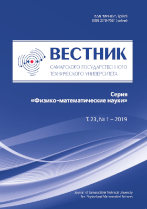|
This article is cited in 2 scientific papers (total in 2 papers)
Mathematical Modeling, Numerical Methods and Software Complexes
Mathematical modeling of the effect of spacers on mass transfer in electromembrane systems
A. V. Kovalenkoa, A. М. Uzdenovab, A. V. Ovsyannikovac, M. H. Urtenova, R. A. Bostanovb
a Kuban State University, Krasnodar, 350040, Russian Federation
b Umar Aliev Karachay--Cherkess State University, Karachayevsk, 369202, Russian Federation
c Financial University under the Government of the Russian Federation, Moscow, 125167, Russian Federation
(published under the terms of the Creative Commons Attribution 4.0 International License)
Abstract:
The transfer of ions near ion-exchange membranes causes concentration polarization, which significantly complicates mass transfer in electromembrane systems. Spacers are used to neutralize the effect of concentration polarization and increase mass transfer. Spacers reduce the thickness of the boundary layer by increasing the mixing depth of the solution and creating a normal component of convective transport; ions can reach membranes faster, and the current increases, from a hydrodynamic point of view. However, spacers significantly increase the hydrodynamic resistance and consequently the cost of pumping the solution.
For the first time, the main regularities of the transfer of salt ions in the desalination channel of an electrodialysis apparatus with spacers of various shapes and arrangements are determined, taking into account electroconvection, in overlimiting current modes. Namely, it is shown, using the current-voltage characteristic, that spacers of different shapes and locations are optimal at different stages of the desalination process.
The paper presents the results of mathematical and simulation modeling of the salt ion transport process in electromembrane systems with spacers in overlimiting current modes. 2D direct numerical simulation was carried out for the coupled system of the Nernst–Planck–Poisson and Navier–Stokes equations without fitting parameters. The finite element method was used in combination with the method of successive approximations and segregation to solve boundary value problems for systems of nonlinear differential equations with partial derivatives. The novelty of the method lies in the fact that after discretization in time, the problem on each time layer is split into hydrodynamic and electrochemical problems, each of which is solved by the method of successive approximations until a complete mutual agreement.
Keywords:
electromembrane system, spacers, mass transfer, ion transfer, mathematical model.
Received: July 25, 2022
Revised: September 7, 2022
Accepted: September 13, 2022
First online: September 26, 2022
Citation:
A. V. Kovalenko, A. М. Uzdenova, A. V. Ovsyannikova, M. H. Urtenov, R. A. Bostanov, “Mathematical modeling of the effect of spacers on mass transfer in electromembrane systems”, Vestn. Samar. Gos. Tekhn. Univ., Ser. Fiz.-Mat. Nauki [J. Samara State Tech. Univ., Ser. Phys. Math. Sci.], 26:3 (2022), 520–543
Linking options:
https://www.mathnet.ru/eng/vsgtu1944 https://www.mathnet.ru/eng/vsgtu/v226/i3/p520
|

| Statistics & downloads: |
| Abstract page: | 313 | | Full-text PDF : | 213 | | References: | 41 |
|



 Contact us:
Contact us: Terms of Use
Terms of Use
 Registration to the website
Registration to the website Logotypes
Logotypes